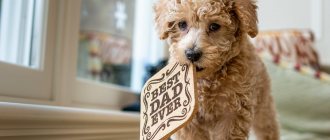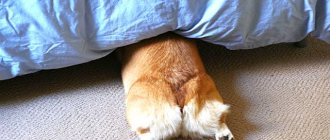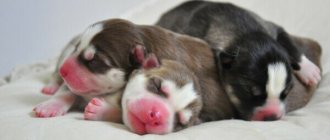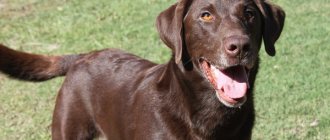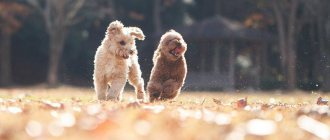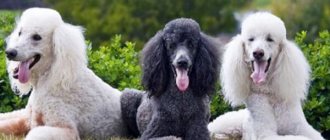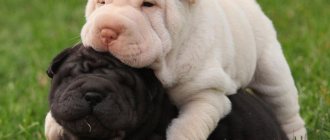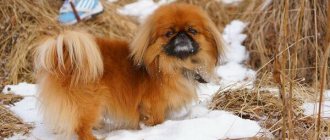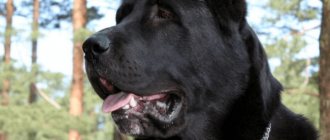Color is a canine term that refers to the color of a dog's coat. It is one of the most important traits when breeding dogs. The standard of any breed establishes acceptable and unacceptable colors. Dogs can surprise you with their colors. Each breed of dog has its own color and pattern, therefore, trying to find a puppy with an uncharacteristic color for a given breed is a pointless exercise.
Poodles are considered one of the smartest breeds in the world. They are highly trainable. Bored poodles can become destructive if left untrained. But active owners who can meet the needs of Poodles will find a lively, intelligent, trainable and the best companion for the whole family.
- Country of origin : France
- Height at the withers : large 45 – 60 cm, small 35 – 45 cm, dwarf 28 – 35 cm, toy 24 – 28 cm
- Weight : large 20 – 30 kg, small 8 – 14 kg, dwarf 6 – 8 kg, toy ~2.5 kg
- Lifespan : 12-15 years
- Use : companion dog, hunting
- Other names : royal poodle (large poodle)
What it looks like in the photo
The poodle is one of the most popular dogs around the world and according to psychology professor Stanley Coren, these animals take 2nd place in the ranking of the smartest dogs.
According to the standard, there are 4 types of these dogs:
- standard (large, royal) – height at the withers ranges from 45 to 60 cm;
- small or medium – grows up to 35-45 cm;
- miniature or dwarf – height at withers from 28 to 35 cm;
- toy poodle – height less than 28 cm.
The Poodle has a proportional body and is one of the typical mesomorphs who look quite elegant and harmonious . The back is short but flexible, the chest is deep, and they have a strong loin.
The neck is quite strong and has a beautiful curve. The head is elongated, the skull is convex in shape with a clearly defined bump on the back of the head, there is a smooth transition from the forehead to the muzzle.
The eyes are almond-shaped, slightly slanted . Their color varies from almost black, deep brown to amber.
The wool can be corded or curly. Corded wool looks like a fleece, thick, long, the length of each cord is about 20 cm. Curly wool is thin and soft, quite thick, and forms beautiful curls throughout the body.
The ears are hanging type, rather long, set low.
If there is curly hair, the animal's tail is docked by ½ or 1/3. With a corded coat, the tail is left unchanged .
During the active state it is placed above the top level.
Standard colors:
- white;
- black;
- apricot;
- brown;
- grey.
Genetics of poodle colors
The most notable feature of the Poodle dog breed is their unique curly coat. The owners of these pets go to any lengths to make them even more beautiful - they do all sorts of haircuts and styling, braids and ponytails, and come up with a variety of hairstyles. But in addition to the texture of the coat, its color is also important; the type of coat and even the temperament of the dog depends on it. The color of the coat will depend on the color pigment, on the factors that distribute it along the length of the hair, influence the color saturation and determine the presence of spots. Pigments have the form of grains of various shapes, due to which light rays are refracted at different angles and human eyes perceive this refraction as different colors. The coloring of dogs is determined by two groups of pigments - eumelanins (black, brown) and pheomelanins (yellow, red).
The breed is rich in a variety of colors
The B gene locus and the F gene locus are responsible for the process of pigment synthesis in the body. The A gene locus and the E gene locus are responsible for the distribution of pigment along the length of the hair and throughout the body.
Character and temperament
Poodles are an active and cheerful breed; they always infect others with their optimism. The temperament is friendly and benevolent, so such a pet never shows aggression towards strangers or other animals.
Poodles are completely devoted to their owner and show excellent results when trained..
They learn commands with particular ease and carry them out with pleasure; they can perform complex tricks, due to which this breed is widely used in the circus arts.
IMPORTANT!
Despite their outward decorative appearance, these pets have a keen sense of smell and are excellent swimmers, so they are often used as gun dogs when hunting hares and birds.
In the absence of proper upbringing, the pet's character can deteriorate greatly; it will become capricious and disobedient . This situation can be prevented by starting training from the first month of the puppy’s life.
The poodle is a social dog, so if left alone for a long time, the animal gets sick and may even die.
The animal loves active games, so it will happily support its owner during hiking or country walks.
They feel great in the city, so they can be kept in apartment conditions..
Buying a puppy
Before purchasing a Miniature Poodle, you need to weigh the pros and cons of such a decision. From the moment the puppy crosses the threshold of the house, the life of its inhabitants will change. You will have to include caring for your dog into your usual daily routine. It will take time to walk and raise the dog, to prepare a diet and go to the veterinarian.
To purchase a puppy, it is advisable to contact a specialized nursery, where they will issue documents for the dog, show its parents, and familiarize them with the rules of keeping. How much does a Miniature Poodle puppy cost? The price depends on the class of the dog and the reputation of the breeder. As for the average cost, it starts from $100 and can reach several thousand for elite show puppies.
Main types
According to the standard of the International Canine Federation dated January 23, 2015, there are 4 main types of poodles.
Large (standard, king)
The largest representative of the described family. Despite its large size, the animal is as energetic as its other relatives.
The height of this animal is at least 38 cm, weight is within 20-32 kg . They live from 15 to 18 years.
The pets are friendly and get along well with children. They never bark or bite strangers for no reason.
The animal's fur does not cause allergic reactions, so animals are also popular among people who suffer from allergies to dog hair. The pet is often trimmed.
The most popular types of haircuts for the royal poodle are the English saddle and continental..
Small
Height at the withers ranges from 35 to 45 cm . In character they are almost identical to royal poodles. Such pets are quite obedient and friendly, and have a good disposition.
Due to their high speed and agility, this type of animal is often entered into agility or flyball competitions.
Dogs are small in size, so they can easily be kept in an apartment, but they require daily moderate-intensity exercise.
The lifespan
of this type of poodle is 12-15 years .
Miniature (dwarf)
These animals are very similar in appearance to royal poodles, the difference is only in size (height at withers 27-35 cm, weight 6-8 kg) and higher mobility.
As a result, such pets need more attention and require regular, and most importantly, high physical activity.
This type of poodle is the easiest to train, which is why these representatives can most often be seen in the circus.
When participating in exhibitions, animals are decorated with various hairpins and clips, although this is not necessary; the hair of these dogs grows in such a way that it does not interfere with the view and has an aesthetic appearance.
Toy poodles are absolutely not aggressive towards strangers, but if they receive insufficient attention they can feel jealous . Prolonged loneliness is fraught with the development of depression for a dog.
This type of poodle is not suitable for families with small children, since when playing with the dog they may not calculate the strength, thereby harming the pet’s health.
The lifespan of the breed is from 14 to 16 years.
The American Kennel Club has designated miniature poodles as a separate breed..
Toy poodle
The determining factor of this breed is considered to be their height, which does not even reach 28 cm. The smallest representatives of this variety of poodles received the unofficial name “Tea Cup”.
The pet's weight ranges from 2.5 to 4 kg.
Like other poodles, these animals are quite smart and easy to train. These dogs cannot imagine their life without communication, so even a few days of loneliness can harm the psychological state of the pet.
But, despite their small size and endearing appearance, these representatives of poodles are very proud, therefore, in the absence of due respect for them, they can even bite . They bark often.
Such pets are not recommended for families with small children, since the animal’s bones are very fragile. But these dogs make excellent companions for older people.
The lifespan of a toy poodle is from 12 to 15 years..
Health
The lifespan of a Miniature Poodle depends on the conditions in which it lives, proper feeding and the presence of chronic diseases. On average it is 16 years. There are a number of diseases characteristic of dogs of this breed:
- Ear diseases of an infectious nature.
- Deafness in one or both ears (due to ear diseases or congenital).
- Diabetes (caused by obesity, old age or genetic predisposition).
- Retinal atrophy (gradually leading to cataracts).
- Tendency to cardiovascular diseases.
- Hypothyroidism (cause: dysfunction of the thyroid gland). The first signs of the disease: excess weight, hunger, skin problems.
Types of dogs (with photos and names)
There are several other types of poodles that vary depending on their coat and overall appearance.
shorn
Cropped poodles include representatives of all of the above types of poodles that have curly hair.
Such a coat is regularly trimmed, since when it grows strongly, the animal’s view is blocked and its appearance is far from the canons of canine beauty.
Uncut
Uncut poodles generally have a mane-like coat on their head.
Such animals are bred for home education, but uncut poodles are not allowed to participate in various exhibitions, since such an appearance is considered bad manners among breeders.
Corded
This type includes representatives of different types of poodles with a corded type of coat. The tourniquets look quite impressive, but require constant maintenance.
From puppyhood, the animal is regularly brushed and washed with soap and shampoo designed for coarse hair..
Moisture must be removed with a towel, without using a compressor or hair dryer.
For a beautiful appearance of the coat, it is necessary to sort out individual strands every week for 3-4 weeks, and after they grow back, untangle them at the base.
The final formation of cords is observed when the animal is 3-4 years old..
Cocker (cockapoo)
There are several varieties of cockapoo:
- dwarf – weight no more than 3 kg;
- toy – weight from 3.5 to 5 kg;
- miniature - weight about 9 kg, height at the withers ranges from 35 to 38 cm;
- Cockapoo is a standard that is practically no longer found; weight can reach 30 kg.
They have an attractive appearance, the coat is wavy or straight.
The animal gets along well with all family members, never conflicts with other pets and is ready to compromise if necessary . Pets are curious and optimistic, easily cheering up their owner.
Cockapoos are intellectually developed and easy to train.
Tikap
Tikap looks like a small toy dog.
Height at the withers is less than 25 cm, and average weight is about 2.5 kg.
The animal is bred by breeders, which provokes the likelihood of genetic diseases.
Feeding
The Miniature Poodle's diet should be balanced. In no case should you include fatty foods in your diet: a dog’s weak liver reacts instantly. The main part of the Miniature Poodle's diet consists of meat products. The dog should be fed frozen beef or lamb.
Offal is good for your dog, but it should be boiled before eating. Once or twice a week, the dog should be fed boiled sea fish. The menu includes fermented milk products: cottage cheese or kefir. Don't forget to give your pet semi-liquid cereals and wholemeal bread. To saturate the animal's body with vitamins and minerals, the dog must be fed vegetables.
Basic colors
There are a number of poodle colors that are designated by the Fédération Cynologique Internationale:
- White . Snow-white poodles are quite attractive and photogenic, but there are much more worries with an animal of this color than with all other representatives of this breed. This color option is only suitable for very clean people.
- Black . The most practical color option, since animals of this color get dirty more slowly and are quite attractive in appearance.
- Ginger . With age, the color becomes lighter. Skin color matches coat tone. The eyes are outlined in brown, the nose can be either black or brown. The eyes are brown.
- Chocolate . The coat is dark brown. The tips of the hair on the ears are lighter. The skin is identical to the tone of the coat. The lips and eyes are outlined in dark brown or black. The nose is liver colored. Eyes – rich brown or dark amber.
- Gray . A very complex color, the formation of which occurs over several years. Puppies are born black, but gradually the coat color changes. Upon reaching the age of 1.5 months, a silvery tint to the muzzle and paws can already be seen. To correctly determine the color, the animal can be shaved, then a silvery tint will be noticeable at the root. Skin tone matches coat color.
- Pink . The coat color is pale pink, matching the skin tone.
- Apricot . The wool comes in various shades of apricot, which are close to dark brown or white. The ears are slightly darker than the base color. Puppies are born with a darker color, but gradually the coat becomes lighter. Quite often this color transforms into cream. The skin is white or pink, may have gray-blue shades.
- Peach . The coat color is beige-pink. Skin tone is identical to coat color.
Interesting fact
Many people think that a miniature poodle is no more beneficial than a cat, but a case in 2008 in Orenburg proves the opposite! A gray poodle named Dick, with his diligence, helped catch thieves who, unnoticed by anyone, broke into the door of the dog's owner and robbed the apartment. Dick sat on the staircase and tried to draw attention to the actions of the intruders by barking non-stop. The owner heard barking from the street and hurried home. By locking the door, he was able to detain the criminals caught by this tiny dog until the police arrived.
Haircut types
Since poodles have a coat that needs to be trimmed regularly, and untrimmed pets are not allowed to show, a number of types of haircuts that are perfect for poodles :
- A lion. The classic version of the haircut, characterized by almost complete cutting of the hair on the face, is cut by 1/3 of the throat, forearm, front legs, shins, and back of the thighs. Hair is also removed between the toes, on the rump and in the groin area. Cylinder-shaped cuffs remain on the legs; in the chest area, the fur is trimmed so that the transition to the clipped part forms an oblique line behind the last pair of ribs. In the area of the ears, the hair is trimmed in such a way as to emphasize the roundness of the shape. A spherical or cylindrical pompom is created on the tail (often used for French poodles).
- English lion . Here the same areas are not trimmed as in the previous haircut option. On the back of the body, the hair is shortened by 2.5-4 cm. The muzzle is cut almost to zero. The throat is cut by 1/3, a thin belt 1 cm wide is created between the chest and croup. 2 narrow strips are made on the hind legs, located slightly above the hock joint.
- English saddle . The haircut almost completely follows the outline of the “English lion”; the difference is only in one detail. Starting from the back edge of the mane and on the sides, two semicircles are cut to zero; on the back they are separated by a thin belt of short-cropped wool, merging with the wool of the same length located on the hips and croup.
- Continental . The side part is cut in the same way as a classic lion, but 2 round pom-poms are left on the tops.
- Poopy clip . This type of haircut is also called a puppy cut, since it is widely used to prepare poodles under the age of 18 months for exhibitions. The haircut is quite simple to perform and practical. The coat is cut short only in the area of the toes and muzzle; on the body and paws it is only slightly shortened.
- Modern. A classic haircut option, characterized by ease of execution and practicality. The areas of the muzzle, paws (including the area between the toes) and the base of the tail are trimmed to zero. In other places, the hair is only slightly shortened, and on the paws it is combed so that the contours of the limbs are clearly visible. The length of the hair with this haircut should be at least 1 cm.
Regardless of the type of poodle, this animal is kind and loyal.
But for the normal development of the pet, he should be provided with regular physical activity and constant communication . Don’t forget about haircuts, the pet’s appearance is a reflection of the owner.
From the history of the appearance of the breed
Rock art of poodle dogs appears on Roman tombs from the 30s BC, as well as on Greek coins dating back to the Middle Ages. It is difficult to calculate the exact time of the appearance of the breed, but already in the 16th century these dogs were widespread throughout Europe.
Clubs in Germany and France simultaneously began developing breed standards, which is why there was a constant dispute between them about the right to be called the founder of the breed.
In 1936, Germany withdrew from the competition, and from now on France is considered the birthplace of this breed, which is a small dog.
The poodle is, first of all, a decorative breed of dog, created to be caressed by the love of its owners.
The smallest poodle was bred from a large poodle, which is considered standard and is not a decorative breed, but a service and sporting breed. Unlike the royal and medium, the toy poodle is a young breed that appeared only in the 20th century. The main goals of selection when breeding it were to reduce its size as much as possible and give it a particularly decorative appearance, so that the dog would resemble a charming toy. The latest FCI standard for the breed was registered in 2007.
